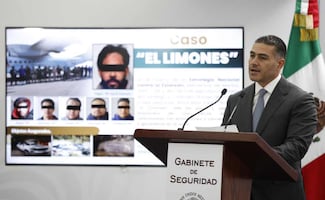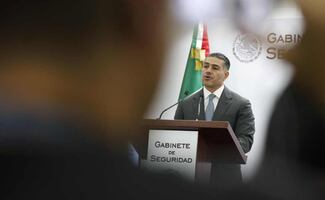Más Información

Harfuch informa avances del caso "El Limones"; UIF congela cuentas y descarta vínculos, por ahora, con Pedro Haces o sindicatos

FGR obtiene vinculación a proceso contra César Duarte, exgobernador de Chihuahua; se le acusa de lavado de dinero

María Amparo Casar y la presunta pensión ilícita de Pemex por la que la FGR la investiga; esto es lo que se sabe del caso

Cae grupo dedicado al robo de autotransporte; Gabinete de Seguridad reporta operativos en Edomex e Hidalgo
A Mexican human rights group on Thursday released what it says are military documents that show high-ranking officers had given soldiers standing orders to kill criminals ahead of an army mass slaying of suspected criminals who had surrendered.
The documents appear to be the first evidence that soldiers involved in the June 30, 2014, killing of at least 12 civilians in a rural area west of Mexico City could argue they had been following orders.
They also indicate that high-ranking military officials knew immediately that something had gone wrong, according to the report from the Miguel Agustín Pro human rights center.
"Soldiers should operate on a mass scale at night and reduce daytime activities, with the aim of killing criminals at night," read the orders signed June 11 by Lt. Col. Sandro Díaz Rodríguez, commander of the command of the 102 Infantry Battalion.
"This is the first time that express orders have been documented that would encourage the commission of serious human rights violations," the rights center said in the report. It said it was given the documents from military court files as part of an appeal on behalf of one of the survivors.
The Defense Department did not immediately respond to a request for comment on Thursday.
The documents show that the army opened a criminal investigation the same day of the incident, yet issued a press release saying the 22 died after soldiers came under fire and responded to defend themselves. In fact, a human rights investigation found between 12 and 15 were killed unarmed or after surrendering. Three women who survived the attack later came forward to say that agents of the Mexico State prosecutor's office had tortured them to support the army's version.
One of the survivors, whose daughter was among those killed, spoke publicly for the first time about the shootings Thursday. "I want justice to be done, justice for what they did to my daughter. God will not forgive them," said Clara Gómez.
The Defense Department has said the killings in the municipality of Tlatlaya were the work of seven soldiers charged in the case, and has not implicated any ranking officers.
The events occurred when an army patrol came upon on a group of armed people in a warehouse who were believed to be members of a drug cartel. After a brief initial exchange of gunfire, in which one soldier was wounded and at least two of the suspects were killed, the remainder surrendered or were disarmed.
Questions about the killings were first brought to light by an Associated Press report that pointed out contradictions in the army's account. AP journalists who visited the scene three days after the shooting found little evidence of a long gun battle. Instead, the walls showed a repeated pattern of one or two closely placed bullet holes surrounded by spattered blood, giving the appearance that some of those killed had been standing against a wall and shot at about chest level.
"If the order was to kill, then that is a violation of the (army's) manual on use of force ... because lethal force can only be used in certain circumstances," said security analyst Alejandro Hope, a former official in Mexico's domestic intelligence service. "This may open the discussion of how high up the investigation of the Tlatlaya case should reach ... whether the investigation should include the whole chain of command."
The Mexican army has been allowed to participate in law enforcement and anti-drug operations only under a role of "assisting" police and prosecutors.
The Armed Forces Manual on the Use of Force states that soldiers "can only use their firearms in legitimate defense of themselves or of other people, in cases of danger of imminent death or serious injury, or to prevent the commission of a crime that involves a threat to life, and only in the case where other less extreme measures are insufficient to achieve those objectives."
In a transcript of a statement to prosecutors, one of the accused soldiers repeats the Spanish word "abatir," or "kill," when asked what he did on the morning of June 30. That is the word contained in the standing orders the unit received when deployed to the area..
In November, three of the soldiers on the patrol were charged with aggravated homicide and four others, including a lieutenant, were charged with "actions improper to the public service" for failing to report the killings.
There have been no trials or verdicts in the case.
Late Wednesday, the Mexico State prosecutor's office formally accused seven state police officers of torturing the three women. Four of the police officers have been detained and a judge is expected to issue an arrest warrant for the other three, according to a statement from the office.
Noticias según tus intereses
[Publicidad]
[Publicidad]










